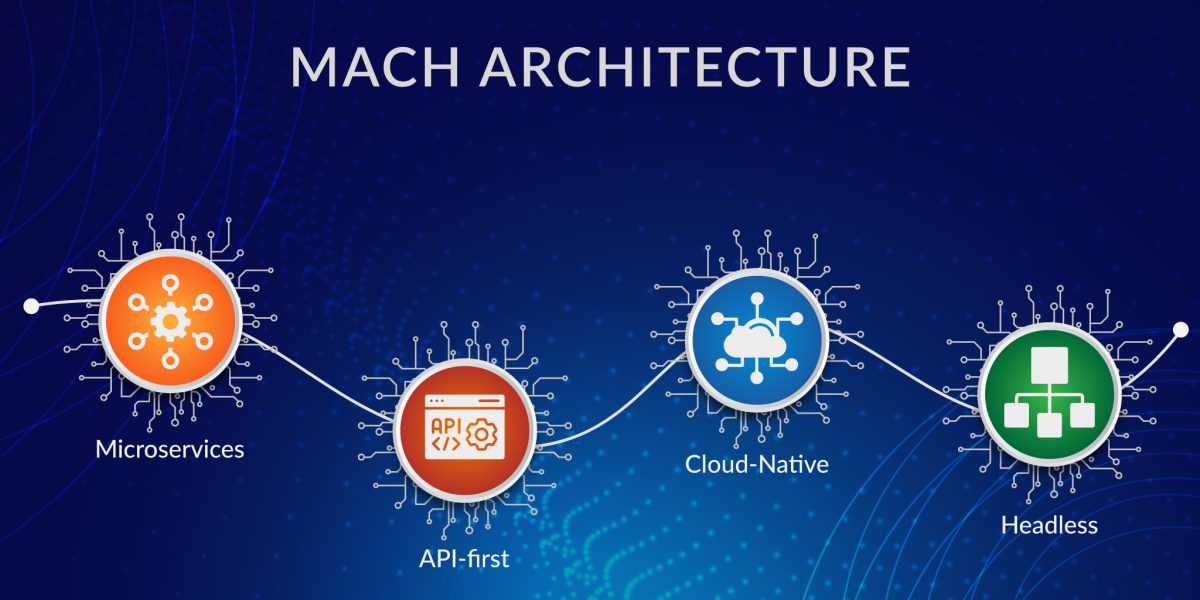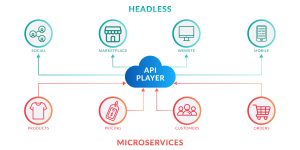
Composable commerce is a modular approach to building e-commerce platforms, allowing businesses to select and integrate different technologies to create customized solutions. This flexibility enables quick adaptation to market changes and evolving customer needs, fostering innovation and providing a competitive edge.
In the fast-paced world of eCommerce, the demand for flexibility, scalability, and resilience is more crucial than ever. Traditional monolithic architectures, where the entire application is constructed as a single, interconnected unit, have shown to be inflexible and challenging to manage as businesses expand and customer demands change.
Enter MACH architecture – a contemporary approach that transforms how eCommerce platforms are developed and operated. MACH architecture is a set of technology principles that underpin modern, best-of-breed platforms. This contemporary approach in eCommerce stands for Microservices, API-first, Cloud-native, and Headless. Each component is essential in building a flexible, scalable, and efficient eCommerce platform.
Microservices
Microservices break down a large application into smaller, independent parts, each with its own responsibility. Each microservice is a single service designed to support an application feature and handle specific tasks. Each microservice communicates with other services through simple interfaces to solve business problems. For example, an eCommerce platform could have separate microservices for product catalogue, user management, order processing, payment, and shipping.
Benefits:
- Independence: Teams can independently develop, deploy, and scale microservices.
- Flexibility: Different technologies and programming languages can be used for various services.
- Resilience: Fault isolation ensures that a failure in one service does not affect the entire system.
Implementation Steps:
- Identify Boundaries: Divide the eCommerce platform into distinct business capabilities.
- Develop Independently: Form small, specialized teams responsible for each microservice.
- Use Containerization: Utilize tools like Docker and Kubernetes for efficient management and deployment of microservices.
- Implement Communication: Use lightweight protocols such as HTTP/REST or messaging queues for inter-service communication.
API-First
This feature serves as the central connection point in the MACH architecture. It facilitates synchronization among different applications or microservices, ensuring seamless integration of all individual code components. By enabling multiple software elements to interact with other products and services, it streamlines the development process. APIs simplify and accelerate software development, reducing time and resource investments.
Benefits:
- Consistency: Ensures uniform communication standards across services.
- Interoperability: Makes it easier to integrate with third-party services and platforms.
- Developer Experience: Simplifies development through clear API documentation and defined contracts.
Implementation Steps:
- Design APIs Early: Define APIs prior to functional implementation using tools like Swagger/OpenAPI.
- Maintain Versioning: Ensure backward compatibility through effective API versioning.
- Use API Gateways: Manage and secure APIs with solutions such as Kong or Apigee.
- Document Thoroughly: Provide comprehensive API documentation to aid developers in understanding and utilizing them effectively
Headless
Headless e-commerce is currently a leading trend in the market. It involves decoupling the front end and back end of a website, with data exchanged via API requests. This setup enables the independent development of the front end(head) and allows it to consume data from the backend via APIs.
Benefits:
- Omnichannel Experience: Provide consistent user experiences across web, mobile, IoT, and other platforms.
- Flexibility: Choose different front-end technologies or frameworks without impacting the back end.
- Faster Iterations: Develop and deploy frontend changes rapidly without affecting the backend.
Implementation Steps:
- Decouple Front-End and Back-End: Ensure that backend services expose APIs for frontend consumption.
- Choose a Headless CMS: Use a headless CMS like Contentful, Strapi, or Sanity to manage content.
- Develop Front-End Independently: Utilize modern frontend frameworks like React, Vue, or Angular.
- Integrate Seamlessly: Ensure smooth integration between frontend and backend through well-defined APIs.

Cloud Native
This refers to software where development and delivery are hosted on the cloud. With the business’s constantly changing needs and demands, this model provides out-of-the-box solutions and doesn’t require frequent installation or maintenance. Updates and upgrades happen automatically without any customer effort, downtime, costs, or other fees. Hosting e-commerce on the cloud platform helps in scaling the business infinitely. In this way, cloud infrastructure provides sophisticated scaling capabilities to meet growing demands over time.
Benefits:
- Scalability: Easily scale resources up or down based on demand.
- Cost-Efficiency: Pay only for the resources you use, optimizing expenses.
- Resilience: Benefit from high availability and disaster recovery options provided by cloud services.
Implementation Steps:
- Choose a Cloud Provider: Select a provider like AWS, Azure, or Google Cloud based on your needs.
- Adopt Cloud Services: Utilize cloud-native services such as managed databases, serverless computing, and auto-scaling groups to enhance flexibility and efficiency.
- Automate Infrastructure: Implement Infrastructure as Code (IaC) tools like Terraform or AWS CloudFormation for managing and automating cloud resources.
- Monitor and Optimize: Use monitoring tools to track system performance and optimize the use of resources to ensure efficient operation.
Practical Use Cases of MACH in eCommerce
- Personalization: Utilize microservices for personalized recommendations based on user behaviour data.
- Omnichannel Retail: Implement a headless architecture to provide a seamless shopping experience across online stores, mobile apps, and in-store kiosks.
- Scalable Promotions: Utilize cloud-native services to scale promotional campaigns during peak seasons, ensuring responsiveness under heavy traffic.
- Seamless Integrations: Use APIs to integrate with various third-party services such as payment gateways, shipping providers, and marketing tools.
Challenges and Considerations
- Complexity: Managing multiple microservices and ensuring smooth communication can pose challenges.
- Security: Secure APIs to safeguard functionalities against unauthorized access.
- Data Consistency: Ensure consistent data across microservices through meticulous planning.
- Cost Management: Effectively manage cloud resources to control and optimize costs.
Composable Commerce
MACH Architecture forms the foundation of Composable Commerce. Headlessness, a key aspect of MACH, marks the initial step towards achieving Composable Commerce.
Headlessness dismantles monolithic structures by separating frontend and backend functionalities, enabling them to operate autonomously and enhancing flexibility and agility. However, mere headlessness alone does not fully unlock the spectrum of benefits for modern commerce.
Moving towards composable commerce involves advancing to the next level, where the focus shifts to assembling the customer experience by integrating components like cart, checkout, and order management from diverse vendors. Each component retains independent customization and replacement capabilities, catering precisely to desired customer experiences.
Thus, the principles of Composable Commerce align closely with the MACH architecture.
In a microservices architecture, the entire eCommerce solution is divided into smaller, manageable services that can be individually scaled and managed as needed.
The API-first approach ensures seamless communication between components, even if they are developed by different vendors.
The cloud-native aspect allows businesses to develop and deploy their entire eCommerce solution on any cloud platform, enhancing scalability, security, and reliability.
Closely related to the cloud-native approach is the SaaS model, where applications are hosted online and automatically kept up to date.
A headless approach involves decoupling the frontends from the backends, laying the foundation for a modular architecture that is essential for composability.
Conclusion
In summary, the MACH architecture offers a robust framework for constructing eCommerce platforms in a modular way, adeptly managing the complexities and rapid changes of the digital marketplace. By incorporating microservices, an API-first approach, cloud-native infrastructure, and headless architecture, businesses can achieve:
- Scalability: The capability to expand and efficiently manage increased traffic and workloads.
- Flexibility: The agility to adopt new technologies and meet customer demands swiftly and effectively.
- Resilience: The ability to sustain functionality even when individual components fail.
- Efficiency: Enhanced operations and streamlined development processes, facilitating faster innovation and deployment.
Adopting the principles of Composable Commerce through MACH architecture enables eCommerce businesses to deliver exceptional customer experiences, respond quickly to market trends, and maintain a competitive edge in the continuously evolving digital landscape.













